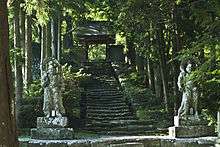Futago-ji
Futago-ji (両子寺) is a Tendai Buddhist temple in Kunisaki, Ōita Prefecture, Japan. It is located on the slopes of Mount Futago, the highest mountain on the Kunisaki Peninsula. The temple was established in 718 by Ninmon and became the central temple of Rokugō-Manzan (六郷満山).[1]
| Futago-ji 両子寺 | |
|---|---|
 Stone Niō (1814) at the entrance to Futago-ji | |
| Religion | |
| Affiliation | Tendai |
| Location | |
| Location | Kunisaki, Ōita |
| Country | Japan |
| Architecture | |
| Founder | Ninmon |
| Completed | 718 |
| Website | |
| www | |
The temple precincts are a Prefectural Historic Site included within a Special Zone of the Setonaikai National Park.[1][2][3]
Treasures
- Seated wooden statue of Amida Nyorai (late Kamakura period) (Prefectural Cultural Property)[4]
- Stone tō (Kamakura period) (Prefectural Cultural Property)[4]
- Pair of wooden masks (1618, 1770) (Prefectural Cultural Property)[4]
- Stone tō (Nanbokuchō/Muromachi period) (City Cultural Property)[4]
- Stone tō (1468) (City Cultural Property)[4]
- Stone tō (Muromachi period) (City Cultural Property)[4]
- Stone Niō (1814), 245 and 230 cm (City Cultural Property)[4]
- Wooden statue of Jūichimen Kannon[5]
- Wooden statue of Fudō Myōō[5]
- Raigō painting[5]
gollark: Maybe there should be those things.
gollark: Idea: Forth to Lisp compiler.
gollark: I wonder how they do the type inference. My friend was complaining about that being undecidable on stacks or something.
gollark: Not sure,=.
gollark: Mildly apioforom.
See also
References
- "Futagoji - Home". Futagoji. Retrieved 1 February 2012.
- "Ōita bunkazai". Ōita Prefecture. Retrieved 1 February 2012.
- "Setonaikai National Park - Map 4" (PDF). Ministry of the Environment. Retrieved 1 February 2012.
- "Kunisaki bunkazai - Futagoji". Kunisaki City. Archived from the original on 15 November 2012. Retrieved 1 February 2012.
- "Futagoji - bunkazai". Futagoji. Retrieved 1 February 2012.
External links
- Official website (in Japanese)
- Kunisaki Tourist Association information
- Map of Setonaikai National Park (in Japanese)
This article is issued from Wikipedia. The text is licensed under Creative Commons - Attribution - Sharealike. Additional terms may apply for the media files.